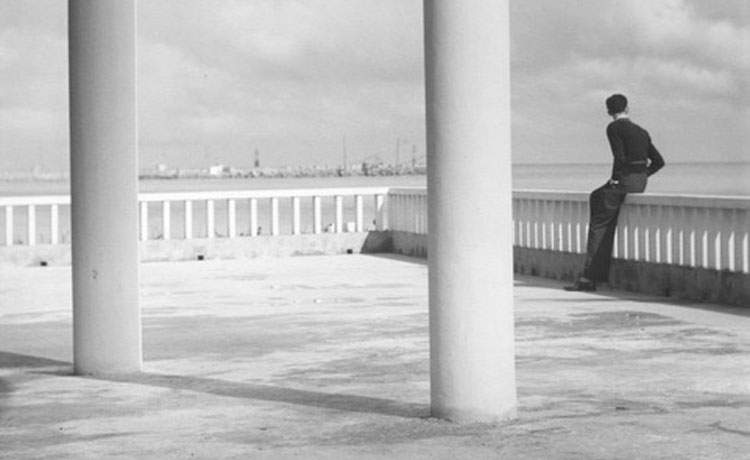The essentiality of the Cavalli brothers' photography on display in Senigallia
In Senigallia, at Palazzo del Duca, the exhibition Diverse Solitudes. Giuseppe and Emanuele Cavalli Photographers, curated by Angela Madesani. A tribute that Senigallia City of Photography wants to pay to two of the finest Italian photographers of the 20th century. For the first time, the shots of the Cavalli brothers will be exhibited in the same context to celebrate with an anthological exhibition Giuseppe, who lived in Senigallia for more than twenty years, and his twin brother Emanuele, known to most as a painter but who was also a photographer of great quality.
Sixty photographs by Giuseppe and fifteen by Emanuele will be on display. Some of them are unpublished ones from the Giuseppe Cavalli Archive that constitute a small anthology with nudes, still lifes, landscapes and portraits. Subjects that were dealt with most by Cavalli. These photographs are distinguished by their essentiality, every detail is studied, and there is a focus on composition and spatiality.
“Cavalli’s constant subject is light, or rather, luminosity for its own sake,” says curator Angela Madesani. “His works and these images in the exhibition are clear evidence of this, they speak of existence in a broad sense. They are images of slowness, deserving of long, dilated times of observation. There are no rules for understanding his work; it is best to simply look to try to enter the depths of the Cavallian world: a world filled with meaning, which is anything but aestheticizing.”
Emanuele Cavalli ’s images are also largely unpublished, with the exception of some exhibited in 1993. In both painting and photography the latter focuses on form, which he said he pursues in its absolute precision, without the variables of light and color. In his works one notices the influences of 1930s American photography, the rigor of the Bauhaus and the painting of Cézanne.
“The photographs in the exhibition almost all depict still lifes,” Madesani adds, “some of them simpler while others consist of real compositions created specifically by the artist, such as the image of the glass sphere and the black spiral made in 1936 in Anticoli Corrado, a shot of great modernity that is affected by the artist’s international knowledge. Also for Emanuele, essentiality and attention to composition are the main characteristics to be pursued, both in pictorial and photographic works.”
Comparing the works kept in the archives of the two brothers, one notices so many points in common, some shots always attributed to one are found in the other’s archive and vice versa. This is precisely the theme of the exhibition: the continuous creative exchange between the brothers and a possible reinterpretation of their production unhinged by the pair that over the years has always read Giuseppe as a photographer and Emanuele as a painter.
“The work of both is poetic, lyrical, without ever being corny or pretentious,” the curator continues. “The two brothers were great, each with their own inclinations, their own specificities, their own outcomes, and the exhibition is not meant to be a competition between them, but a demonstration of the importance of the two paths, parallel, sometimes tangent, both fundamental within the Italian art scene.”
Both approached photography in the 1930s. For them it is “a medium and as such it can also be used to give life to research of an artistic nature, and quality documentary photography can also be understood in this sense,” the curator tells. “What counts is the project, the intention, the thought, but also the ability to handle the optics, the negative, its printing and therefore the quality of the final outcome.”
In the 1940s Giuseppe became the animator of the photographic group La Bussola together with, among others, Mario Finazzi and Federico Vender, among the most exciting experiences in the history of twentieth-century Italian photography.
From an idea of his, a new association was later born, the MISA group, where the most promising young people could converge and mature in order to include them in the elitist circle of La Bussola: Cavalli was now considered a master and it was during this experience that a young Mario Giacomelli would take the courage to exhibit his work.
Giuseppe Cavalli has always approached photography as a means of artistic research not inferior to other tools, and in this he has always been close to his brother Emanuele, who, from what emerges from his writings, has never posed the question of whether photography is art or not, since it just is: this exhibition intends to bring out the artistic nature of the two artists’ research.
Image: Giuseppe Cavalli, Solitaire, 1948(?) Bonori Family Collection, © Eredi Giuseppe Cavalli
 |
| The essentiality of the Cavalli brothers' photography on display in Senigallia |
Warning: the translation into English of the original Italian article was created using automatic tools. We undertake to review all articles, but we do not guarantee the total absence of inaccuracies in the translation due to the program. You can find the original by clicking on the ITA button. If you find any mistake,please contact us.





























